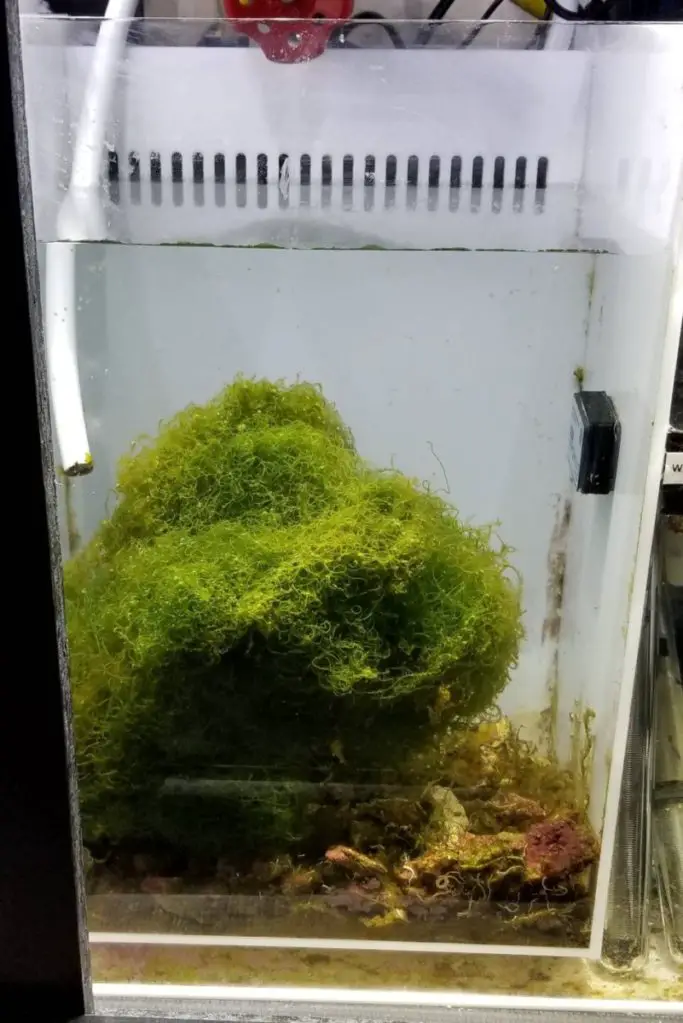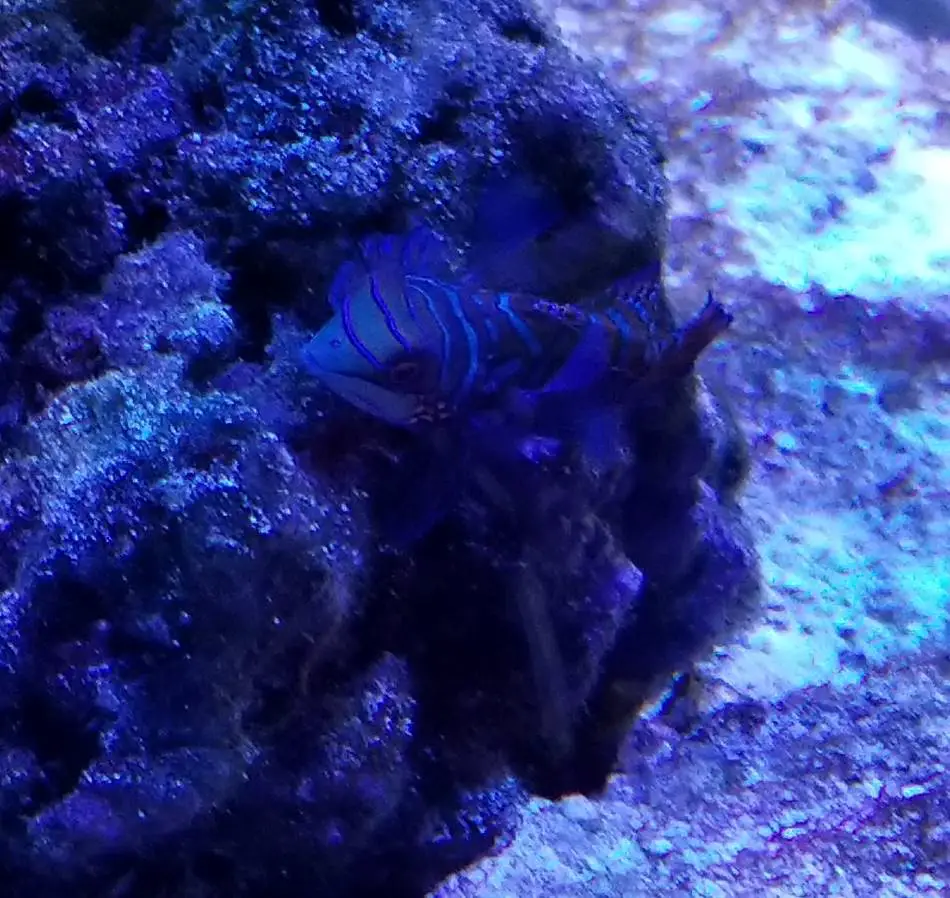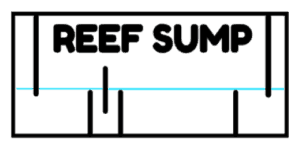
The aquarium refugium is a separate but connected tank or vessel that shares the same water as the main display tank. A refugium can be a chamber in the sump, a separate tank, or even a hang on the back refugium. As the name implies a refugium serves as a refuge for its inhabitants safe from the perils and predators in the main display tank.
Hang on the back refugium
What animals can I put in the refugium? Fish, snails, shrimp, corals, crabs, corals, and copepods can all be put in the refugium. Though all of these animals can live in the refugium doing so could impact the goals you may have for your refugium.
In this article, I detail different animals that you could keep in the refugium and some of the reasons why you would or wouldn’t want to keep certain animals in the refugium. I will also share my typical refugium setup and my goals when having a refugium.
Before placing any livestock please make sure that your refugium is a suitable habitat for the species you want to place in the refugium. The right environment will vary between species, sizes, flow, lighting, and other factors. Simply stated do not place livestock in a refugium if it is not a suitable habit for the animal.
Keeping Fish in the Refugium

Keeping fish in the refugium is possible depending on the refugium size and what else exists in the fuge. Most fish have a minimum tank size recommendation and unless you have a very large sump it can be hard to meet size recommendations. Some fish may require high flow which is generally not found in refugiums. Others might need a specific type of base like a deep sand bed. Make sure you know what care requirements your fish needs and match that in the refugium environment as close as possible. With that said here are some ideas and experiences where I’ve seen fish successfully kept in larger refugiums.
Using the Refugium as a Time out Penalty Box
Occasionally you may have an aggressive fish that needs to be separated from the main display. The refugium can be a good spot to hold the aggressive fish until you have a plan for bringing peace to the tank. If you can catch the fish, place it in the refugium and determine the next steps. Sometimes just removing the fish temporarily from the display will help reduce aggression if you reintroduce it to the main display. With the aggressive fish removed from the system, it gives the other tank inhabitants a chance to reset the hierarchy and establish new territories. After a few days, you can reintroduce the segregated fish back in the main display and see how it goes.
If reintroduction fails and aggression continues it may be time to look at re-homing the aggressive fish. In this case, the fish can be removed and held in the refugium until you are able to find a suitable home for the aggressive fish. A fellow reefer looking for that particular species or your local fish store may be able to help.
Using the Refugium to Acclimate Fish
The refugium can be a good option for the acclimation of fish, especially delicate fish. A good example of this introducing a Mandarin Goby to your tank. These fish are often very timid, somewhat fragile, and can be easily bullied by established tank mates. Placing the Mandarin in the refugium gives it a chance to acclimate to the tank water parameters and a new environment in peace. Additionally, Mandarin Gobies can be very picky eaters often preferring live food such as copepods. If you have a well-established pod population in your refugium, acclimating your mandarin in the fuge gives the fish a smorgasbord of food for it to have while it adjusts to its new environment. The only drawback here is that Mandarins eat a lot as they forage throughout the day and in a contained refugium environment it is possible for the fish to decimate copepod populations.
AlgaeBarn Live Copepods & Phytoplankton
POSEIDON’S FEAST LIVE COPEPODS: Imagine having a sustainable & diverse copepod population in your marine aquarium. Poseidon’s Feast contains 3000+ Premium LIVE Tigriopus and Tisbe Copepods ranging from nauplii to adult sizes.
Keeping Specific Species full time in Refugiums
It is possible to keep specific species of fish full time in refugiums, just be sure that the environment meets the species needs including size, lighting, flow, and habitat (i.e. sand bed/rock work). I have a friend who has a peaceful mixed reef display tank and was enamored with Frog Fish Anglers. Frog Fish use their dorsal fin kind of like a fishing rod bending it in front of their mouth enticing other fish and inverts to investigate. When this happens the Frog Fish opens it’s largemouth and engulfs its prey. To say the least Frog Fish Anglers don’t make for very friendly tank mates in a peaceful mixed reef.
My friend’s solution was to place an angler in the refugium where he had a low flow, some live rock, and a light. My buddy would occasionally feed his angler live shrimp and occasionally small fish having success with his angler for many years.
I have also seen other refers who have fish spawn in their aquarium and successfully raise baby fry in refugiums. This is not an easy thing to do and the two species I saw were clownfish and bangai cardinals.
Crabs, Snails Shrimps, and other Inverts
Crabs, snails, shrimps, and other inverts are all possibilities to have in your sump. Snails can be particularly useful if you deploy a sand bed in your refugium. Many species of snails such as the sand sifting nassarius snail can help keep the sand bed from settling and becoming a nitrate factory. Crabs and shrimp also can do pretty well in the refugium and act as a cleanup crew in the refugium scavenging waste and detritus.
Coral Frags
Using the refugium can be a great place to house coral frags if you run out of space in your main display or just don’t want frags in the main display. About the same considerations with fish and inverts apply to corals. You will need to know what corals you are housing in the refugium and be mindful of the right lighting and flow needed for them to be healthy.
An easy setup is to place a coral frag rack in the refugium, add a powerhead sized to achieve optimum flow for size and species, and light up the refugium with a light capable of delivering the spectrum need for specific corals being kept in the refugium.
The Classic Refugium Setup with Copepods, Amphipods, and Macroalgae
Call me traditional, but for me, I only use my refugiums for what they are classically intended for, a refuge from the main tank. I leave the livestock to the main display and put my refugium to work for the main display. I like to set my refugium up to provide a food source for the display, export nutrients, and balance PH levels at night.
I keep both copepods and amphipods in my refugium. These micro critters are wonderful for the reef aquarium and serve as important members of a biological cleanup crew and a food source for fish and corals. Pods consume organic waste in the reef aquarium and their tiny size allows them to get in the nooks and crannies of rock and other parts of the aquarium that would otherwise go unclean. There are many fish species that forage throughout the day and consume pods as part of their normal diet. After a refugium is seeded with pods they will reproduce, populate, and some will make their way naturally into the display tank.
Pods also can live and thrive in macroalgae. Macroalgae serves a special function as a nutrient export. Most reef aquarium macroalgae literally consume nitrates and phosphates from the tank. I prefer to use chaetomorpha (chaeto) in my refugiums. Chaeto is a fast-growing macroalgae that doesn’t pose much risk for making its way unwanted into the display tank. As Chaeto grows consuming nitrate and phosphates in the process, it should be trimmed back on occasion to continue the nutrient export cycle. When you remove a portion of the chaeto, you are manually removing excess nutrients from the tank and increase your odds of a healthy reef tank ecosystem.
With Chaeto in the refugium it is important to provide appropriate light to the macroalgae as it is also a plant conducting photosynthesis. Lighting your refugium at night also has the benefit of stabilizing PH levels through the night. In the daytime photosynthesis is happening in the tank with a CO2 increase as a byproduct with CO2 increases PH levels. When the lights go down at night photosynthesis stops, CO2 drops, and PH levels drop. To combat this PH swing one can run their refugium light cycle in reverse by lighting the fuge at night. A high-quality light in the right spectrum for macroalgae will go a long way in growing and keeping your macroalgae healthy.
What are the Best Substrates to Use for a Refugium?
Related Questions
Where does the word refugium come from? The origin of the word refugium comes from Latin meaning a place of refuge and originated in the 1940s.
What is the difference between a Copepod and Amphipod? Copepods and Amphipods are two different species of microcrustaceans. Both play similar roles in the reef aquarium as effective biological waste control and a food source for fish and corals. The biggest difference that the reef keeper will observe is the size difference. Amphipods are much larger and easier to see.


